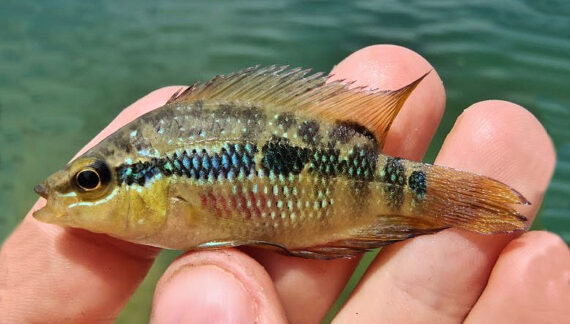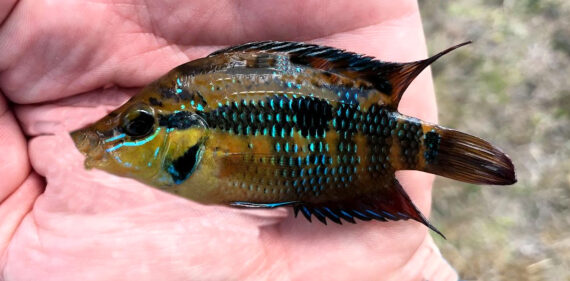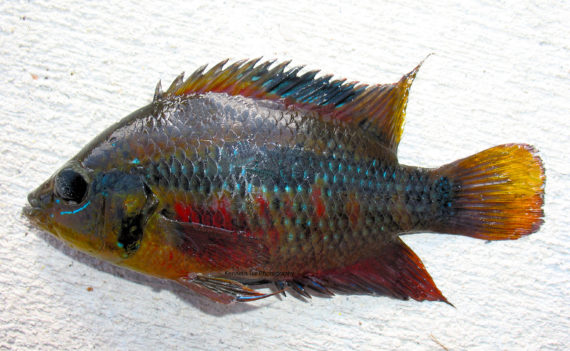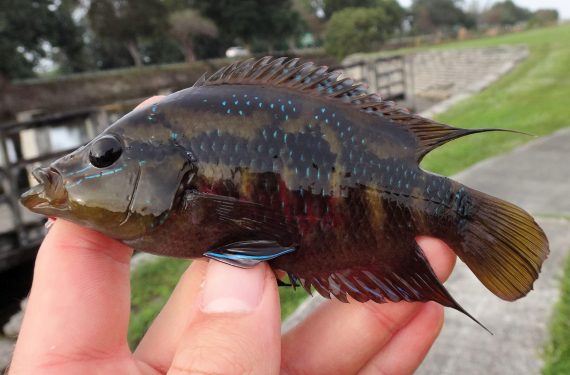Yellowbelly Cichlid, Trichromis salvini
 Yellowbelly Cichlid, Trichromis salvini. Fish caught from an irrigation canal in the greater Orlando, Florida area, November 2020. Length: 7.2 cm (2.8 inches). Catch, photograph, and identification courtesy of Josh Leisen (joshadventures.com), Gaylord, Michigan.
Yellowbelly Cichlid, Trichromis salvini. Fish caught from an irrigation canal in the greater Orlando, Florida area, November 2020. Length: 7.2 cm (2.8 inches). Catch, photograph, and identification courtesy of Josh Leisen (joshadventures.com), Gaylord, Michigan.
 Yellowbelly Cichlid, Trichromis salvini. Fish caught from an irrigation canal in the greater Orlando, Florida area, July 2019. Length: 7.2 cm (2.8 inches). Catch, photograph and identification courtesy of Luke Ovgard, Klamath Falls, Oregon.
Yellowbelly Cichlid, Trichromis salvini. Fish caught from an irrigation canal in the greater Orlando, Florida area, July 2019. Length: 7.2 cm (2.8 inches). Catch, photograph and identification courtesy of Luke Ovgard, Klamath Falls, Oregon.
 Yellowbelly Cichlid, Trichromis salvini. Fish caught from with Markham Park, Sunrise, Florida, March 2018. Length: 8.5 cm (3.3 inches). Catch, photograph and identification courtesy of Ryan Crutchfield, Tampa, Florida.
Yellowbelly Cichlid, Trichromis salvini. Fish caught from with Markham Park, Sunrise, Florida, March 2018. Length: 8.5 cm (3.3 inches). Catch, photograph and identification courtesy of Ryan Crutchfield, Tampa, Florida.
 Yellowbelly Cichlid, Trichromis salvini. Fish caught from an irrigation canal in the greater Miami, Florida area, November 2022. Length: 9.1 cm (3.6 inches). Catch, photograph and identification courtesy of Ben Cantrell, Sebastian, Florida.
Yellowbelly Cichlid, Trichromis salvini. Fish caught from an irrigation canal in the greater Miami, Florida area, November 2022. Length: 9.1 cm (3.6 inches). Catch, photograph and identification courtesy of Ben Cantrell, Sebastian, Florida.
 Yellowbelly Cichlid, Trichromis salvini. Fish caught out of the New River, Sunrise, Florida, December 2012. Length: 10.1 cm (4.0 inches). Catch, photograph and identification courtesy of Kenneth Tse, Toronto, Ontario, Canada.
Yellowbelly Cichlid, Trichromis salvini. Fish caught out of the New River, Sunrise, Florida, December 2012. Length: 10.1 cm (4.0 inches). Catch, photograph and identification courtesy of Kenneth Tse, Toronto, Ontario, Canada.
 Yellowbelly Cichlid, Trichromis salvini. Fish caught from the drainage canals in Tampa, Florida, December 2013. Length: 12 cm (4.7 inches). Catch, photograph and identification courtesy of Ben Cantrell, San Diego, California.
Yellowbelly Cichlid, Trichromis salvini. Fish caught from the drainage canals in Tampa, Florida, December 2013. Length: 12 cm (4.7 inches). Catch, photograph and identification courtesy of Ben Cantrell, San Diego, California.
 Yellowbelly Cichlid, Trichromis salvini, Breeding Female. Fish caught from the drainage canals in Tampa, Florida, December 2013. Length: 20 cm (7.9 inches). Catch, photograph and identification courtesy of Eli (obsessiveangling.wordpress.com).
Yellowbelly Cichlid, Trichromis salvini, Breeding Female. Fish caught from the drainage canals in Tampa, Florida, December 2013. Length: 20 cm (7.9 inches). Catch, photograph and identification courtesy of Eli (obsessiveangling.wordpress.com).
The Yellowbelly Cichlid, Trichromis salvini, is a member of the Cichlid and Tilapia or Cichlidae Family, that is also known as Salvini’s Cichlid and the Tricolor Cichlid and in Mexico as guapote tricolor and mojarra pico de gallo. This species was very recently reclassified from the Parachromis Genus tand placed in the Trichromis Genus in 2015. Globally, there are six species in the genus Trichromis, of which one, this species, being found in the freshwater systems of Mexico.
The Yellowbelly Cichlid has an elongated, deep, oval-shaped, and compressed body with a shape similar to that of an elongated bluegill. They are yellow overall and have 4 black horizontal lines across their forehead and 2 lines of black spots running down the middle and upper middle of their body. They have greenish-blue dots on their body. Their anal and caudal fins have red tips. Their colors are more intense in breeding females and in fish caught in the wild. They are dimorphic, especially when breeding. Females are more intensely colored and develop reddish coloring along their back and belly and black spots with blue edges in the middle of their dorsal fin and the edge of their gill cover. Males are larger than females and have more pointed fins; they develop blue streaks on their head and blue hues along their back. In contrast, juveniles are drab yellow or gray in color. Their head has a pointed snout, large eyes located high on the head, and a large mouth with a longer lower jaw equipped with strong canine-like teeth. Their anal fin has 7 or 8 spines and 9 rays; their caudal fin is rounded; and, their dorsal fin has 17 spines and 10 or 11 rays. The middle rays of their anal and dorsal fins are the longest.
The Yellowbelly Cichlid is found in moderate to fast moving waters of rivers and lagoons at elevations up to 459 m (1,500 feet) with water temperatures between 24oC (75oF) and 30oC (86oF). They are found in jungle and tropical forest areas that include a variety of substrates such as muddy, rocky or sandy bottoms which are generally off-colored and have an abundance of aquatic vegetation, organic debris, driftwood, and related cover. The off-colored juveniles are found in bodies of water with higher water flow than those inhabited by adults. Due to their striking colors, adults rely on camouflage from their habitat and the presence of numerous other fish species to avoid predation by birds. They reach a maximum of 22.0 cm (8.7 inches) in length. They are omnivores that feed on small fish and small aquatic and terrestrial invertebrates. Reproduction is oviparous with each female laying between 500 and 600 eggs in well-protected areas. Eggs are fertilized externally by males and then stick to the substrate. Large numbers of eggs are required to maintain population levels as fry and juveniles are prone to massive kill rates due to predation and changes in habitat such as large water flows. Males vigorously defend the territory while females mind the eggs. The fry hatch within a few days and are guarded by both parents for up to one month. They grow rapidly and reach sexual maturity quickly. They have lifespans of up to thirteen years in captivity.
he Yellowbelly Cichlid is a resident of the freshwater systems of southeast Mexico from the Papaloapan River basin and the coastal lagoon of Mandinga in the states of Campeche, Chiapas, Quintana Roo, Tabasco, Veracruz and Yucatán.
Due to its unique coloration pattern, the Yellowbelly Cichlid cannot be easily confused with any other species.
From a conservation perspective the Yellowbelly Cichlid is currently considered to be of Least Concern with stable, widely distributed populations. Their long-term viability is threatened from nutrient and pesticide run off from agriculture practices, the introduction of invasive species into their habitat and human development. There are currently non-indigenous populations established in Florida and Texas, presumably from aquarium releases, where they have become highly invasive. The Yellowbelly Cichlids is of limited interest to most, however, they are a very popular aquarium fish since the drab-colored juveniles undergo dramatic and very attractive color changes with maturity. Live specimens are available for purchase online or in fish stores. They require fairly large aquariums as they are moderately aggressive, highly territorial, and intolerant of intruders and also require a high level of maintenance.